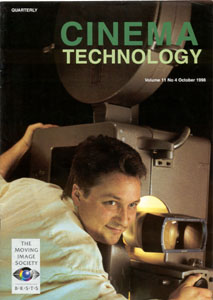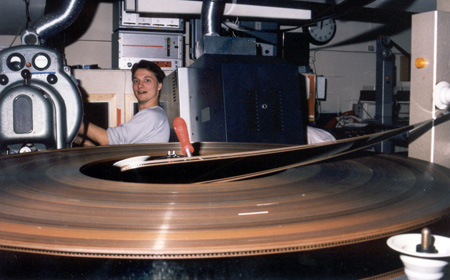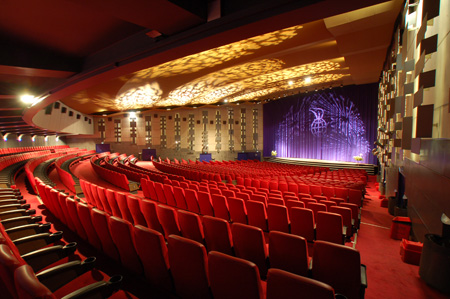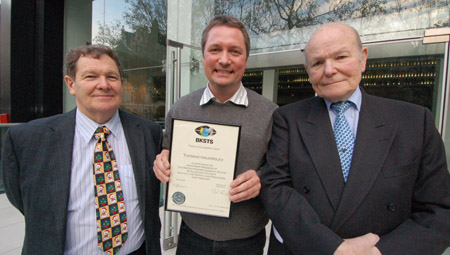|
| |
Meet the Chief:
Thomas Hauerslev |
Read more at
in70mm.com
The 70mm Newsletter |
|
This article first appeared in Cinema
Technology October 1998, as a chapter in the ongoing series of "Meet the Chief" articles.
Re-published her with permission from Mr. Jim Slater, editor of Cinema Technology. |
Updated 26-01-10
+ 17.01.2021 |
 In
this article, former projectionist Mr. Thomas Hauerslev (Born 1963)
takes you on a tour of his universe in Copenhagen in his native Denmark.
Mr. Hauerslev was a projectionist in Copenhagen for a number of years
(1982 - 1994) and is presently busy raising two children, working full
time as a Temporary Agent at the European Environment Agency, editing
The 70mm Newsletter and collecting 70mm projection equipment for a
future 70mm museum. In
this article, former projectionist Mr. Thomas Hauerslev (Born 1963)
takes you on a tour of his universe in Copenhagen in his native Denmark.
Mr. Hauerslev was a projectionist in Copenhagen for a number of years
(1982 - 1994) and is presently busy raising two children, working full
time as a Temporary Agent at the European Environment Agency, editing
The 70mm Newsletter and collecting 70mm projection equipment for a
future 70mm museum.
I have had one special movie interest: 70mm films. It is a great joy for me to see a rock-steady 70mm image on a large curved screen and listen to 6-track stereo. Thanks to the high resolution (even from a blow-up) it is a very intense experience for me to see 70mm.
One of my fist contacts with the cinema was in the early 70s, when I saw "The Guns of Navarone" at the Imperial Bio in central Copenhagen. Little did I know that I would be working as a projectionist at the Imperial 15 years later. My younger brother Henrik and I regularly attended cinemas from 1977 and onwards. This was around when "The Spy Who Loved Me" and "Close Encounters of the Third Kind" opened. I quickly became familiar with the cinemas of Copenhagen.
Unhappy with gymnasium, I dropped out and began as projectionist apprentice in April 1982 at 3 Falke Bio in Copenhagen. My first film alone was a rotten print of "Quo Vadis" with several stops during the performance. The 3 Falke Bio had opened in October 1958 with "South Pacific" and "The Miracle of Todd-AO" in Todd-AO. This was the first Todd-AO installation in Scandinavia, 1000 seats in stadium style seating, a huge curved 70mm screen and 6-track stereo. The projectors were the Philips
DP70 (Norelco AAII). There were two sets of curtains and individual masking for all formats. I was very happy working there.
Unfortunately the 3 Falke Bio closed in December 1982 and I lost my dream job. In April 1983 I had a brief encounter with City Bio, a run-down cinema near Town Hall Sq. dating back to 1898. They had a pair of Bauer U3 70/35 projectors. They never ran any 70mm, however. The screen was small, flat and not very impressive. There was always a pungent odor smell of decay and I soon left. The cinema was closed in 1989 and demolished.
|
More in 70mm reading:
Reflecting on Projecting
Thomas Hauerslev Receives BKSTS
Award
The 70mm Newsletter
Internet link:
BKSTS /
International Moving Image Society
|
 "Out
of Africa" in 70mm at the ABCinema, fall 1986. Image: Stig Westergaard "Out
of Africa" in 70mm at the ABCinema, fall 1986. Image: Stig Westergaard
My next job was at ABCinema+D in central Copenhagen managed by Nordisk Film, the oldest movie company in the world (Founded in 1906). The ABCinema+D opened in 1974 as ABcinema, but very quickly, screens C and D were added. It was one of the first multiplex cinemas in Denmark. The cinema, except screen D which was located next door, was built on the ground floor inside The Palace Hotel in a former nightclub (Ambassadeur). The projectors were Bauer B14 and Bauer U4. Very reliable 35mm projectors. There were Bauer, Kinoton and Christie platters. The number of seats were 110 in the smallest (Screen C) and 289 in the largest (Screen B). Screen sizes were not very impressive. All screens were flat and only screen B was equipped with Dolby Stereo (CP50).
The best film I ran at ABCinema+D was undoubtedly "Amadeus". We ran it for 16 months, 3 times a day. I must have seen it several dozen times. I even ran it for myself in the middle of the night every once in a while. I think my favorite line from "Amadeus" is "Too many notes, just cut a few, and then itīll be fine". Simply hilarious! The funniest film was "Monty Python Live at the Hollywood Bowl" and the best joke here was "Drinking American Beer is like making love in a canoe! Itīs fucking close to water".
Across the roof from the main projection room we often visited our neighbors at the
Grand cinema to borrow equipment. In 1986 Nordisk Film courageously installed a used Bauer U3 70mm projector and a ST270 Kinoton platter. "Out of Africa" was running in 70mm and 4-track stereo. It was great fun for us to install, except nobody cared about 70mm and the film was taken off after two weeks. In comparison, it had run for 9 months at the Imperial Bio in 70mm before we got it.
ABCinema+D closed after the last performance March 31, 1989
(In 1992, ABCinema was turned into a Ripley's Museum,
and for afew months they ran Motion Master 70mm films). All projectionists were on duty that evening and we closed in style; one projectionist per screen.
A few times every week, I migrated cross the square to the Cinema 1-8 with 8 screens. Projectors were Bauer U4 and a single Bauer B11. Platters were Bauer, Kinoton and Christie. The size of these cinemas ranged between 60 and 120. Although they were small cinemas, Cinema 1-8 was very successful. The projection rooms were located in 5 different rooms on 3 floors. When I started, only screen 1 had Dolby Stereo. The rest were mono. I enjoyed working there, mainly because it was fun to run 8 cinemas and make all performances look as good as possible. Besides that, I really got good
exercise.
|
|
 In
1987 I was offered a job running films at the
Imperial Bio. At that point I was working at ABCinema+D and Cinema
1-8, but I was eager to run at Imperial Bio too. That was also an
opportunity to work with my projectionist friend and mentor, Mr. Rene
Pfaff. He has always been a great inspiration to me and he has a
fantastic sense of humor. In
1987 I was offered a job running films at the
Imperial Bio. At that point I was working at ABCinema+D and Cinema
1-8, but I was eager to run at Imperial Bio too. That was also an
opportunity to work with my projectionist friend and mentor, Mr. Rene
Pfaff. He has always been a great inspiration to me and he has a
fantastic sense of humor.
The Imperial Bio is a very large cinema
with a 16 meter curved 70mm screen. All projection lenses were
ISCO Ultra Star HD and for the 1,85:1 format, an
ISCO Ultra Star Studio is used. Imperial has 1102 seats (originally
1521) and has recently received a
THX certificate. The projectors are DP70 and a complete range of digital sound formats are installed:
Dolby Digital, DTS (both 70mm and
35mm) and SDDS. In 1991, 35mm CDS
(Cinema Digital Sound) was installed for "Terminator 2".
All amps and speakers
are JBL, but that does not
necessarily guarantee good sound. I remember in 1989, a new
JBL 4675-2 setup was installed, but it did not sound significantly
better compared to our old JBL installation. It didn't sound really good
until a technician from Dolby
Laboratories in
London, familiar with large auditoriums, came a year later and fine
tuned the equalizer. He had the ear to tune it. In my opinion,
JBL is the only true speaker for the cinema. JBL has a "West Coast
sound" not found in any other speaker. The system is of course bi-amped
and all amplifiers are located behind the screen, except the surround
amps.
There are 5 shows a day: 11:30 AM, 2:00 PM, 4:30 PM,
7 PM and 9:30 PM. Before the feature we have 5 - 7 minutes of
commercials and some trailers. When the feature begins houselights are
turned off. A working day for a projectionist would begin at 11:00 AM
and end at 5:30 PM, or from 5:30 PM until around midnight. I preferred
double shifts, 12-14 hours. The hourly wage was DKK 63,10 (GBP 6,5) in
1983 and DKK 95,00 (GBP 10) today.
The best thing that happened to me at Imperial Bio was meeting my future
wife Charlotte. I met her in the box office selling tickets for
"The Last Emperor". I completely fell for her smile. In 1985 I decided to get a formal education on top of my projectionist
job and I "offered my services" to the
Danish Railways. While working 40 hours weekly at the railways, I
kept running films at ABCinema+D
and Cinema 1-8 in the evening and during weekends. Only rarely did I
work fewer than 70 hours weekly for a couple of years. In 1994 I left
the projectionist business when I became a father to my daughter Maria.
By that time I only ran one Saturday every 4 weeks, and I decided to
quit while it was still fun.
|
|
 ABCinema+D
on a winter day in 1985. ABCinema+D
on a winter day in 1985.
In 1994 I was offered the opportunity to become the editor of
The 70mm Newsletter and I said
"Yes". Within the frame of my interest for 70mm history I travelled to the USA in 1997 with
Mr. Willem
Bouwmeester. We met and talked with several engineers, including Brian O'Brien, Jr and Dr Walt Siegmund who made the Todd-AO system nearly half a century ago. Needless to say it was very exciting to meet these gentlemen and listen to their stories. I have 6 hours of interviews on audio tape waiting to be edited and published.
The expenses of making the newsletter are astronomical. I have two very important financial supporters, The Decatron Group in Belgium and Nordisk Film Biografer A/S in Denmark. Thanks to their enthusiastic support, the subscribers can get The 70mm Newsletter 4 times a year at a relatively modest price. In the future I would like to see The 70mm Newsletter continue to grow and maybe become a way of living for me, but at the moment, I donīt see that as possible. The subject of 70mm and the paying "audience" are too small. I'll continue to publish the newsletter as long as I find it a challenge and out of pure love for the 70mm format. As of now, it is purely philanthropy.
In 1992 I bought a
DP70 projector. Yes, I have a fully operational DP70 70mm projector standing in my home office. It is wonderful. No need for a Ferrari, just get a DP70, to impress the girls! The in-house DP70 is a great conversation piece. Our guests think it is beautiful.
I have a collection of traditional 70mm projection lenses, including
Cinerama (single) lens,
Dimension-150,
Ultra Panavision 70, several ISCO 70mm lenses, Todd-AO Cine Apergon and one of the PROTOTYPE Todd-AO lenses. Quite often people send me DP70 items that were going to the dustbin. They know the items will find a good home here. It is very thoughtful of them and I really appreciate it. I have connected the projector into my Hi-Fi in order to play magnetic sound. The projector takes 220V, so it is easy to make it run. Being an imbecile reading diagrams, projectionist Mr. Stig M Westergaard
and Mr. Bo Hansgaard helped me rewire the projector completely in return for plenty of beer. They are very thirsty by the way.
I have built a 4 (four) foot curved model screen. When you sit (in a regular cinema chair from 3 Falke Bio of course) just below the light beam, just in front of the curved screen, you actually get a strange sensation of sitting in front of a huge 70mm screen. It is very odd and also very logical. You field of view is covered completely by a proportionally correct curved screen.
My screen is a double sided screen with a handle (for easy transportation). It is flat on the rear side in order to demonstrate the difference between flat and curved screen projection WHILE THE FILM IS RUNNING! This feature is quite interesting and probably one of the few places on earth where that is possible.
Besides having my own DP70 projector, another related passion of mine is to record DP70
serial numbers. I have 456+ serial number and 908 DP70
installations recorded. When we are am on holiday, I rarely miss a chance to go to a projection room (My wife is very supportive!) and find some DP70 serial numbers and maybe an odd reel of 70mm film. I have a huge file of pictures, articles and manuals of the DP70, and I am currently working with Mr. Kotte in Holland (whose father made the DP70) to uncover the production story of this amazing machine. The only projector to win an OSCAR!
|
|
 Dion
Hanson, BKSTS CTC Chairman & Cinema Engineer, the editor and Sir Sydney Samuelson, OBE outside the Odeon
Leicester Sq, London, December 2009. Image by David Hilton Dion
Hanson, BKSTS CTC Chairman & Cinema Engineer, the editor and Sir Sydney Samuelson, OBE outside the Odeon
Leicester Sq, London, December 2009. Image by David Hilton
Interested to learn about 70mm in Denmark, I asked around. Nobody knew how many films had been shown in 70mm in Denmark or where they ran. I decided to do the research myself and make a list. The first list was made in 1985. Today, I have enough material to publish a book about all Danish 70mm cinemas and all films shown in Denmark in 70mm (5/70 and 15/70), Cinemiracle and Cinerama. It is in my computer, sitting there waiting until I find the time to edit and publish it (Everything is available on my web site). As the years went on I collected a large number of articles about 70mm films and the technology and about Todd-AO in particular.
My passion for compiling information developed into get more lists: Closed Cinemas of Copenhagen, Closed 70mm Cinemas of Denmark, 70mm Films in Denmark, Projection and Sound Equipment in Copenhagen Cinemas, 70mm Blow-Ups and List of 65mm and other Large Format Films plus the aforementioned
DP70 serial numbers and
DP70 installations.
Professionally, I would like to work for a film museum that would pay me to do Wide Screen research full-time. It would be wonderful if The Danish Film Museum established a Wide Screen Research Department. I'd be happy to join and record the history of many wide screen engineers. Many are still around us, in their seventies, just waiting to tell their stories. These insights and memories have never been recorded systematically, yet we are all living with wide screen every day. Even television is now going wide screen. It is a part of the global movie heritage and only very few museums seem to care.
If that isn't possible, I'll do it myself and build my own Repository of Wide Screen Cinema & Film Museum one day. It will be dedicated to the wide screen motion picture history.
In retrospect I really enjoyed my 11 years as a projectionist. There were so many interesting movies to see, so many projectors and cinemas to play with and not least, many fine colleagues to work with. My hobby was my work, and I felt very good about that. It was a lovely time and I am very grateful for the opportunities given to me. I seem to have forgotten the long boring nights while waiting for the last show to end. Today I have moved on to more international work with the movies and The 70mm Newsletter. I'd like, however, to go back to projecting movies one day, but at the moment I cannot find the time.
Thomas Hauerslev,
MBKS, former projectionist
and now working as a technical assistant with the EU. Spends a lot of spare
time editing not-for-profit "in70mm.com", a dedicated web site about his
love for large format films. Have interviewed many film pioneers and
published numerous articles for Cinema Technology. He feels very fortunate
to have worked with the finest people of the industry, organizing 70mm &
Cinerama screenings in
Czech Republic,
Denmark,
Germany and
United Kingdom.
|
|
| |
|
Go: back - top - back issues
Updated
22-01-2025 |
|
|
|